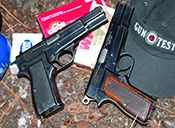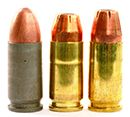We acquired two Hi-Power 9mm look-a likes from Southern Ohio Gun and put them to the test. They were the Israeli-made Kareen (about $375), and the Hungarian FG (about $425). Both were surplus used single-action guns, essentially identical to the original Hi-Power design. Both had all-matching numbers, and that included the barrels and slides. The Kareen had clumsy hard-rubber or plastic grips, worn bluing, and a spur-type hammer. The FG had checkered walnut grips, decent shiny bluing, and a Commander- or ring-type hammer. We shot them with Russian 115-grain FMJ, Cor-Bon 115-grain JHP, and with 147-grain Black Hills Subsonic JHP. Heres what we found.

Israeli Kareen 9mm Para., about $375
We didnt like the grips on this gun because they were ugly plastic with no traction to speak of, and could not be securely tightened on the gun. The bluing was worn on all the edges and had gone to brown on the front and rear grip straps. The magazine was a modern replacement with a slightly damaged base. The approximately 60 to 70 percent remaining bluing was scratched and worn. Once upon a time it had looked good, and the original polish job had been well done. Traces of that good surface remained. The slide spring felt decidedly weak, and may have contributed to the problems we had.
The sights were horrible. The rear was dovetailed into the slide, and there was not enough gap in it. The tiny rounded front was mighty hard to see, even when blacked. The old-style hook or spur hammer was easy to cock, and tended to not pinch our hands as much as do the highly touted ring- or Commander-style hammers. The trigger pull was also atrocious. It required very hard pressure to get the hammer to fall, in the neighborhood of 13 pounds. The barrel looked mighty good inside, and we thought this gun would most likely outshoot the FG, and as it turned out, we were right. Yet we failed this gun.
We found a glitch with this gun that caused us to fail it. We noticed that if you cocked the hammer and put on the safety and then pressed hard on the trigger, there was a click. Then, when you took off the safety, the hammer would fall to the half-cock position. The gun would not fire, so we thought this was borderline acceptable, even though the FG and a Charles Daly Hi-Power on hand didnt do that. It might have been part of the design, we suspected.

But the more we tried it, the more the glitch worsened. We tried to find out what was happening, but ultimately we found that if you cocked the hammer, put on the safety and then pressed the trigger, the hammer would fall past the half-cock notch and the gun would fire. This was easy to test with a pencil in the barrel. Sometimes the hammer would fall when we released the trigger, but the problem was that it began to fall past the half-cock notch and would then propel the pencil out the muzzle up to the ceiling. So it was clear the gun would fire with the safety on. That spells failure in our book. We had concluded our test shooting by the time we found this problem. Happily, we had never relied on the safety during our testing. But that was not all.
During our testing we had numerous failures to feed. We tried a different magazine with the same results. We had failures with all types of ammo tried. We estimated about 60 to 70 percent of the time we had to cycle the slide or tweak it to get the next round into the chamber. Despite that, the gun made respectable groups, on the order of 2.5 inches at 15 yards for five shots, and that despite a horrid trigger. However, because of the many failures to feed in combination with the ultimate failure of the safety device, we thought this gun was one for the garbage can.
Our Team Said: We suspect most of the Kareens problems can be fixed, but we would not be happy with spending lots of extra time and money to get it into good shape.
Hungarian FG 9mm Para., about $425
This gun looked good. Its bluing was shiny and bright, though it had spots of very slight pitting on the left side of the slide, front and rear. The grip panels were like those seen on Belgian Brownings, walnut with a slightly raised, checkered panel. The checkering was worn down but still visible. These would be good practice pieces for the beginning checkerer. The grips were originally varnished, but had nicks and scratches here and there, and signs of oil soaking inside. They were tight on the gun, and felt much more comfortable than those on the Kareen. The sights were quite good. They had three white dots. The front was cut at the back in a slant that gave good definition. The front was wide enough to be easily seen, though wed widen the rear notch a touch. The rear was dovetailed into the slide.
Like the Kareen all the numbers matched. The serial-numbered barrel had significant rust inside. We cleaned it as well as we could, and later found our shooting had polished it up rather well. In a post-test disassembly we found patches of rust here and there, perhaps the result of high-humidity storage. Its a good idea to completely disassemble these guns when you get them, or at some point early in the game, to get all the rust and grit out. The trigger reassembly on the Hi-Powers is tricky, so if youre not up to it, take it to a gunsmith. Or leave the trigger in place and use lots of cleaning solvent.
The trigger felt very rough until we pulled the magazine, and then the trigger pull was smooth. Was there grit on the parts? Field-stripping found lots of grit inside the gun. Field-stripping the Hi-Power type guns is extremely easy, but further disassembly is very much harder than that required for a 1911-type gun. In fact many of us here dont think this design is an overall improvement over the 1911, except for easier field-stripping. To do that, clear the gun and lock the slide fully back with the safety lever into the second notch on the slide. Remove the magazine and press out the cross pin, and pull it free from the slide. Release the safety lever and ease the slide off. The spring can then be removed from the barrel and out comes the barrel. Thats as far as youll usually need to go.
We tested the gun as received, grit and all, and it did well. Once cleaned inside, the gun looked and felt pretty good, we thought. FG made the parts for the excellent discontinued Charles Daly HP, which was assembled in the U.S. This gun lacked the Dalys safety extension and express sights, and of course was not new. But we liked it. The hammer had a bad spot that we decided to try to fix. After our shooting tests we pulled the gun all apart for a massive cleaning. We then filed the side of the hammer to remove the damage and used appropriate abrasives to give both sides of the hammer a bright finish. This improved its looks considerably, and cost nothing.
Even without the gun clean the trigger was not bad, though heavy at 9.5 pounds . To our surprise, given the rough barrel, the gun shot acceptably, though it was not a tack driver. Groups were 3 to 4 inches, depending on load. On the range we had zero problems. The gun fed, fired, and ejected everything perfectly, no matter how fast we shot it. The rounded hammer did some biting on our hands, and wed like a bigger beavertail, but as it was, we thought the gun was a good one. Our best group was 2.3 inches, with about 3.5 inches on average. The strikes were just above point of aim, good enough for combat. The Kareen placed its rounds 6 inches high at 15 yards.
Our Team Said: We thought the FG was a good gun that worked, and though it could probably be improved with some attention, we thought it was fine as is. Its a decent value as a surplus buy.




























